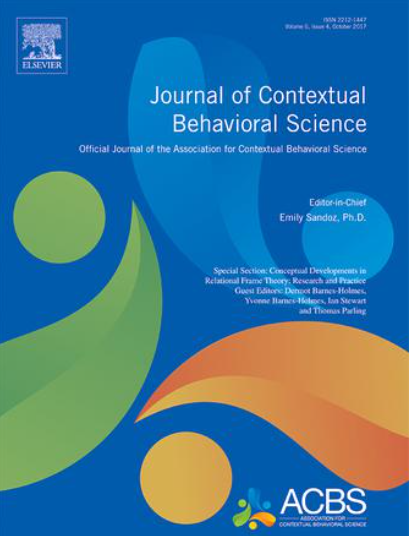The effect and mechanism of acceptance and commitment therapy for young adults’ appearance-based rejection sensitivity and social comparison based on appearances: A randomized controlled trial
IF 3
3区 心理学
Q1 PSYCHOLOGY, CLINICAL
引用次数: 0
Abstract
This study tested the effect and mechanism of acceptance and commitment therapy (ACT) on young adults’ appearance-based rejection sensitivity (ARS) and social comparison based on appearance (SCBA). A sample of 190 university students (Mage = 18.35, SD = 0.78; 56.62% female) was randomly assigned to either the ACT group (n = 94) or an active control group (n = 96), which focused on interpersonal discussions about experiences of appearance-based rejection. Participants completed six weekly group interventions, as well as three surveys: a baseline assessment before the intervention (T1), a post-test immediately after the intervention (T2), and a 3-month follow-up (T3). Clinically significant decreases in ARS and SCBA were observed in the ACT group from baseline to both the post-test and follow-up. Comparisons at each phase indicated that the ACT group outperformed the control group in reducing ARS and SCBA, as well as in improving psychological inflexibility and cognitive fusion. Furthermore, the parallel mediation models supported the mediating roles of psychological inflexibility and cognitive fusion between the ACTintervention and ARS /SCBA. These findings suggest that ACT is effective in reducing ARS and SCBA by improving psychological inflexibility and cognitive fusion. Future research should further explore the effects and mechanisms of ACT on ARS and its related constructs using diversified samples and multiple long-term follow-ups.
接受承诺治疗对青少年外表排斥敏感性和外表社会比较的影响及机制:一项随机对照试验
本研究考察了接受与承诺治疗(ACT)对青少年基于外表的排斥敏感性(ARS)和基于外表的社会比较(SCBA)的影响及其机制。样本为190名大学生(Mage = 18.35, SD = 0.78;56.62%的女性)被随机分配到ACT组(n = 94)和积极对照组(n = 96),后者主要关注人际间关于基于外表的拒绝经历的讨论。参与者完成了六周的小组干预,以及三项调查:干预前的基线评估(T1),干预后立即的后测试(T2)和3个月的随访(T3)。从基线到测试后和随访,ACT组的ARS和SCBA均出现临床显著下降。各阶段的比较表明,ACT组在减少ARS和SCBA以及改善心理不灵活性和认知融合方面优于对照组。此外,平行中介模型支持心理不灵活性和认知融合在act干预与ARS /SCBA之间的中介作用。这些发现表明ACT通过改善心理不灵活性和认知融合而有效地减少ARS和SCBA。未来的研究应通过多样化的样本和多次长期随访,进一步探索ACT对ARS及其相关构式的影响和机制。
本文章由计算机程序翻译,如有差异,请以英文原文为准。
求助全文
约1分钟内获得全文
求助全文
来源期刊

Journal of Contextual Behavioral Science
PSYCHOLOGY, CLINICAL-
CiteScore
8.50
自引率
18.00%
发文量
82
审稿时长
61 days
期刊介绍:
The Journal of Contextual Behavioral Science is the official journal of the Association for Contextual Behavioral Science (ACBS).
Contextual Behavioral Science is a systematic and pragmatic approach to the understanding of behavior, the solution of human problems, and the promotion of human growth and development. Contextual Behavioral Science uses functional principles and theories to analyze and modify action embedded in its historical and situational context. The goal is to predict and influence behavior, with precision, scope, and depth, across all behavioral domains and all levels of analysis, so as to help create a behavioral science that is more adequate to the challenge of the human condition.
 求助内容:
求助内容: 应助结果提醒方式:
应助结果提醒方式:


